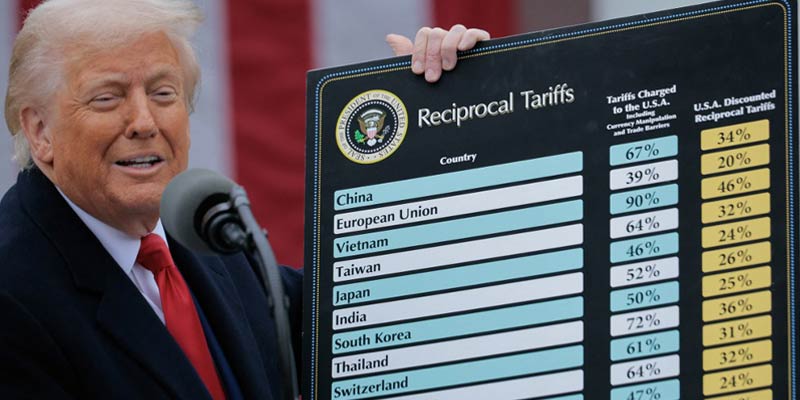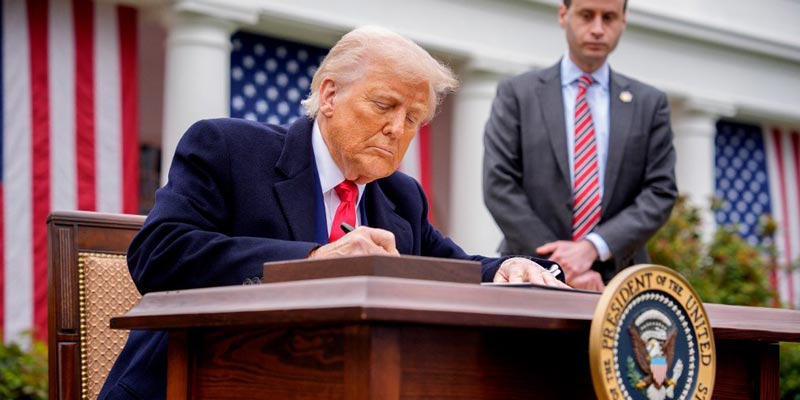- India
- Apr 03
Explainer - What is tariff?
• The US has announced 27 per cent reciprocal tariffs on India saying New Delhi imposes high import duties on American goods.
• The Donald Trump administration aims to reduce the country’s trade deficit and boost manufacturing.
• The move is expected to impact India's exports to the US. However, experts say that India is better-placed than its competitors who also face increased levies.
• Trump’s announcement has intensified a global trade war that threatens to stoke inflation and stall growth. It unleashed turbulence across world markets and drew condemnation from other leaders.
• China, faced with a fresh 34 per cent tariff on top of the 20 per cent Trump previously imposed, vowed countermeasures.
• Japan and the European Union were not spared, facing 24 per cent and 20 per cent tariff rates respectively. The base 10 per cent tariffs go into effect on April 5 and the higher reciprocal rates on April 9.
What is tariff?
• The word tariff has been catapulted from the business pages to the headlines over the last few months, as major economies impose or threaten them on other nations.
• But tariffs are not just a blunt weapon to be used in geopolitical brinkmanship. They can, if used effectively, help poorer countries develop their economies.
• A tariff or duty (the words are used interchangeably) is a tax levied by governments on imported products. Different tariffs are applied on different products by different countries.
• The tariff, along with the other assessments, is collected at the time of customs clearance in the foreign port.
• The UN defines tariffs as customs duties on merchandise imports, levied either on a percentage of value or on a specific basis.
• Historically, tariffs were a major source of revenue for many countries and were often the primary source of federal revenue through the late 19th century. Today, other taxes account for most government revenue in developed countries.
• Tariffs are now typically used selectively to protect certain domestic industries, advance foreign policy goals, or as negotiating leverage in trade negotiations.
• Tariffs are used widely, but they are imposed following rules that have been negotiated within the World Trade Organisation (WTO) or regional organisations.
• Reciprocal tariffs are imposed by countries to counter increases in duties or high tariffs by trading partners. It can be described as a tit-for-tat tax.
• Many important actors in global trade, such as the United States, the European Union and China, are imposing tariffs or measures that are not always in line with their commitments in the WTO.
• When Member States make unilateral decisions, without going through the WTO or UN System, it can create uncertainty, which may end up creating a slowdown in investment decisions in the private sector, in trade, economic growth and job creation.
• There have always been differences among countries, with certain sectors more affected by changes than others, and economic conditions can require certain kind of interventions.
• Developed countries often use tariffs as part of broader economic policies aimed at protecting specific industries or responding to international trade dynamics. In contrast, developing countries may use tariffs more broadly to protect nascent industries and support economic development.
• Experts say that tariffs themselves are not necessarily a problem. The issue is the uncertainty that results from big economic players ripping up the playbook of international trade rules.
• One way of helping an industry develop and grow is by protecting it, through tariffs, from foreign competition. The downside is that production of those goods for the domestic market is more expensive, and you may also deter competition.
• Another important point is governments need revenue. Tariffs are a tax, and a tax is income that a government can spend on social spending, health, education or infrastructure. But again, this means higher costs on imported goods for consumers.
Why has the US announced these tariffs?
According to the White House, these tariffs will help boost domestic manufacturing in the US and cut the trade deficit. The US is facing huge trade imbalances with countries, especially with China. With India, the US has a trade deficit of $35.31 billion in goods in 2023-24.
India’s trade relations with the US
• From 2021-22 to 2023-24, the US was India’s largest trading partner. The US accounts for about 18 per cent of India’s total goods exports, 6.22 per cent in imports, and 10.73 per cent in bilateral trade.
• With America, India had a trade surplus (the difference between imports and exports) of $35.32 billion in goods in 2023-24.
• In 2024, India’s main exports to the US included drug formulations and biologicals, telecom instruments, precious and semi-precious stones, petroleum products, gold and other precious metal jewellery, ready-made garments of cotton, including accessories ($2.8 billion), and products of iron and steel ($2.7 billion).
• Imports included crude oil, petroleum products, coal, coke, cut and polished diamonds, electric machinery, aircraft, spacecraft and parts, and gold.
How will the tariffs impact the trade?
• Goods from India are already facing a 25 per cent tariff on steel, aluminium, and auto. For remaining products, India is subject to a base line tariff of 10 per cent between April 5-8. Then the tariff will rise to country-specific 27 per cent starting April 9. Over 60 countries are affected by the measures.
• Apex exporters body FIEO said that the duties pose challenges for domestic players but India’s position remains comparatively more favourable than that of its competitor nations.
• The exporters said that the proposed Bilateral Trade Agreement will help domestic industry to overcome the possible impact of these duties.
• During the visit of Prime Minister Narendra Modi to Washington in February, both the countries announced negotiations of this agreement with an aim to increase the bilateral trade to $500 billion by 2030. They are aiming at finalising the first phase of this pact by September-October this year.
Manorama Yearbook app is now available on Google Play Store and iOS App Store


